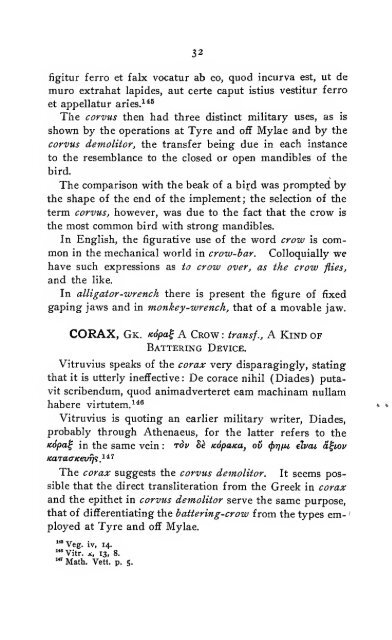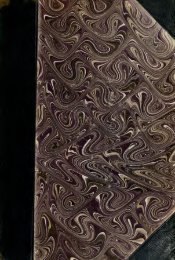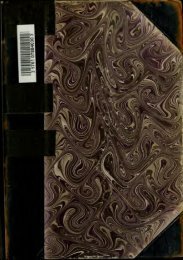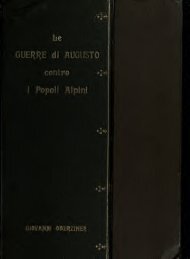Figurative uses of animal names in Latin and their ... - mura di tutti
Figurative uses of animal names in Latin and their ... - mura di tutti
Figurative uses of animal names in Latin and their ... - mura di tutti
Create successful ePaper yourself
Turn your PDF publications into a flip-book with our unique Google optimized e-Paper software.
32<br />
figitur ferro et falx vocatur ab eo, quod <strong>in</strong>curva est, ut de<br />
muro extrahat lapides, aut certe caput istius vestitur ferro<br />
et appellatur aries.^*^<br />
The corvus then had three <strong>di</strong>st<strong>in</strong>ct military <strong>uses</strong>, as is<br />
shown by the operations at Tyre <strong>and</strong> <strong>of</strong>f Mylae <strong>and</strong> by the<br />
corvus demolitor, the transfer be<strong>in</strong>g due <strong>in</strong> each <strong>in</strong>stance<br />
to the resemblance to the closed or open m<strong>and</strong>ibles <strong>of</strong> the<br />
bird.<br />
The comparison with the beak <strong>of</strong> a bird was prompted by<br />
the shape <strong>of</strong> the end <strong>of</strong> the implement; the selection <strong>of</strong> the<br />
term corvus, however, was due to the fact that the crow is<br />
the most common bird with strong m<strong>and</strong>ibles.<br />
In English, the figurative use <strong>of</strong> the word crow is common<br />
<strong>in</strong> the mechanical world <strong>in</strong> crow-bar. Colloquially we<br />
have such expressions as to crow over, as the crow flies,<br />
<strong>and</strong> the like.<br />
In alligator-wrench there is present the figure <strong>of</strong> fixed<br />
gap<strong>in</strong>g jaws <strong>and</strong> <strong>in</strong> monkey-wrench, that <strong>of</strong> a movable jaw.<br />
CORAX, Gk. Kopa^ A Crow :<br />
Batter<strong>in</strong>g Device.<br />
transf., A K<strong>in</strong>d <strong>of</strong><br />
Vitruvius speaks <strong>of</strong> the corax very <strong>di</strong>sparag<strong>in</strong>gly, stat<strong>in</strong>g<br />
that it is utterly <strong>in</strong>effective: De corace nihil (Diades) puta-<br />
vit scribendum, quod animadverteret earn mach<strong>in</strong>am nullam<br />
habere virtutem.^*®<br />
Vitruvius is quot<strong>in</strong>g an earlier military writer, Diades,<br />
probably through Athenaeus, for the latter refers to the<br />
Kopa^ <strong>in</strong> the same ve<strong>in</strong> : tov h^ Kopaxa, oii ^rifii elvai d^iov<br />
The corax suggests the corvus demolitor. It seems pos-<br />
sible that the <strong>di</strong>rect transliteration from the Greek <strong>in</strong> corax<br />
<strong>and</strong> the epithet <strong>in</strong> corvus demolitor serve the same purpose,<br />
that <strong>of</strong> <strong>di</strong>fferentiat<strong>in</strong>g the batter<strong>in</strong>g-crow from the types employed<br />
at Tyre <strong>and</strong> <strong>of</strong>f Mylae.<br />
'"Veg. iv, 14.<br />
"'Vitr. X, 13, 8.<br />
"' Math. Vett. p. 5.<br />
'



![Das Kriegswesen der Alten [microform] - mura di tutti](https://img.yumpu.com/21606999/1/167x260/das-kriegswesen-der-alten-microform-mura-di-tutti.jpg?quality=85)








